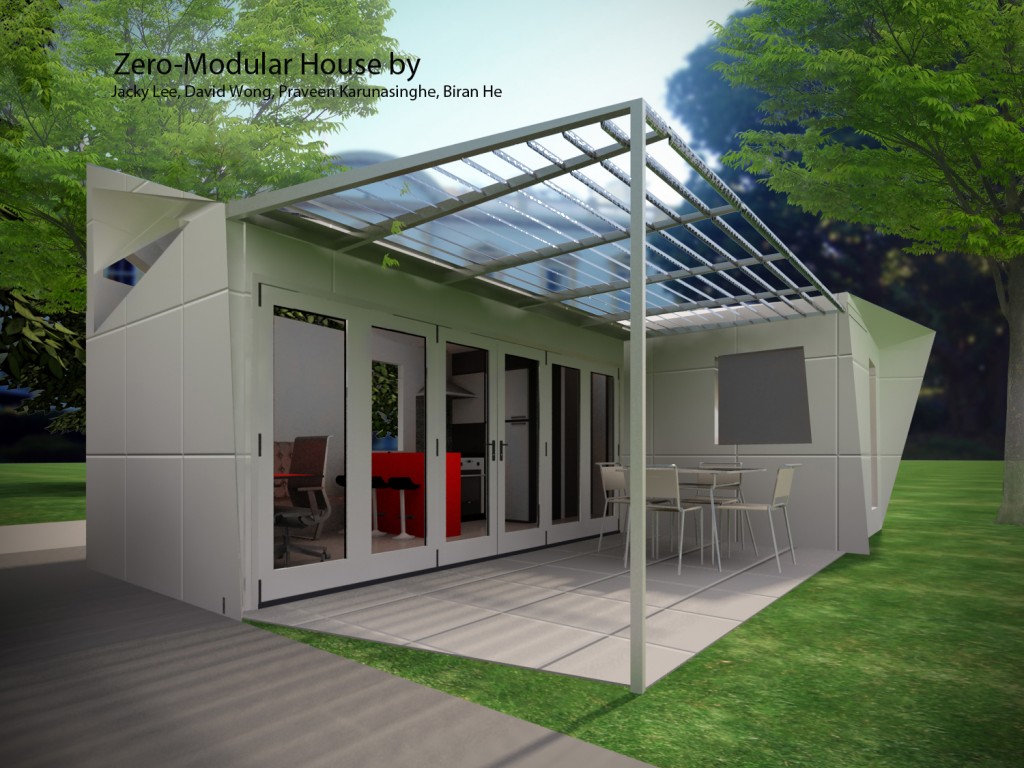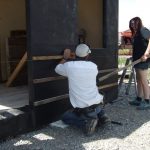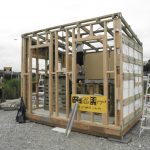The Gap Filler temporary office
In December 2011, a team of young people got together with a vision to build an office for Gap Filler using materials saved from demolition sites around Christchurch. The team developed the design over the summer and with many talented volunteers built the office in a week in January!
The design and build was organised by SHAC in association with the Regeneration and White Elephant charitable trusts. Many skilled and unskilled volunteers helped out – builders, architects, engineers, young people and the occasional passer-by.
All of the building materials are reused, with the exception of building paper, insulation, chicken wire, fixings, clear plastic cladding and 4 sheets of thin treated plywood.
The office has an internal floor area of less than 10 square meters. Our talented designers and builders believe that the office complies with the building code, and is warm, stable, resistant to moisture, durable, and supports fire safety.
This office is experimenting with new building techniques. The east and southern wall structure are made from reused shipping pallets, a technology developed by Mark Fielding of Solabode Ltd in Nelson. The southern wall is clad with reused printing plates kindly donated by the Christchurch Press.
This tiny office will stay here for approximately 3 – 6 months. Power will come initially from neighbours and then, from solar power. Wireless internet access will come from a kind neighbour. Once we leave this site, the office will be relocated on a truck to another vacant site in Christchurch. The internal floor area is less than 10m2 and did not require a building consent.
We are using this land with the generous support of Ascot TV, who lost their building on this site in the earthquakes. They are now located at 300 Colombo Street, up the road.
What’s SHAC?
The Sustainable Habitat Challenge is a network of people designing and building more sustainable buildings and neighbourhoods. SHAC projects are educational in nature, teaching those involved new skills. The buildings they create are designed with non-profit group or charity in mind; in this case, Gap Filler. Gap Filler has been gifted this movable building which will be used as an office..
SHAC – affordable, delightful housing, micro architecture, simple building, and more… SHAC is about living well with less reliance on resources, and finding our purpose. See shac.org.nz for more info.
What’s Gap Filler?
Gap Filler is a creative urban regeneration initiative started in response to the September 4, 2010 Canterbury earthquake, and revised and expanded in light of the more destructive February 22, 2011 quake. It is now administered by the Gap Filler Charitable Trust. See gapfiller.org.nz for more info.
Gap Filler aims to temporarily activate vacant sites created by the quakes within Christchurch with creative projects for community benefit, to make for a more interesting, dynamic and vibrant city. Gap Filler has done a number of projects to date around Christchurch such as a book exchange, painted pianos, a community space and petanque pitch in Lyttelton, and outdoor events such as cinema and live music. Two projects have been completed in Sydenham recently, too – the outdoor chess set next to Honey Pot Café and Wayne Youle’s shadow board mural (working with Christchurch Art Gallery).
THANK YOU to: the landowners – ASCOT TV (especially Chris), Graham at ECO Framing, Barry Dowrick, CPIT and the Otago Polytechnic for the loan of many tools and Mark Fielding of Solabode Ltd in Nelson for the 5 prefab pallet walls and The Christchurch Press for the metal printing plates.
we thank you!
tim, clayton, barnaby, barry, lani, florian, ben, emma, ella, alice, amber, rachel, regan, felicity, alan, nick, seth, naomi, jules, the Australian group of young volunteers, ants, ann, nev, bob, dave, tarn, barry, darcy, Andrew, kyle, nastassja, Shayne, and kerry
Southern Demolition, Terra Lana Insulation, The Pumphouse [See Photo below], The Window Marketplace, Addington Demolition, Christchurch Demolition and Salvage, Clyne and Benny, Skelly Holdings, Dulux, Steel and Tube, White Elephant Trust and F3 Design, Solabode Ltd, Firth, and PSP














